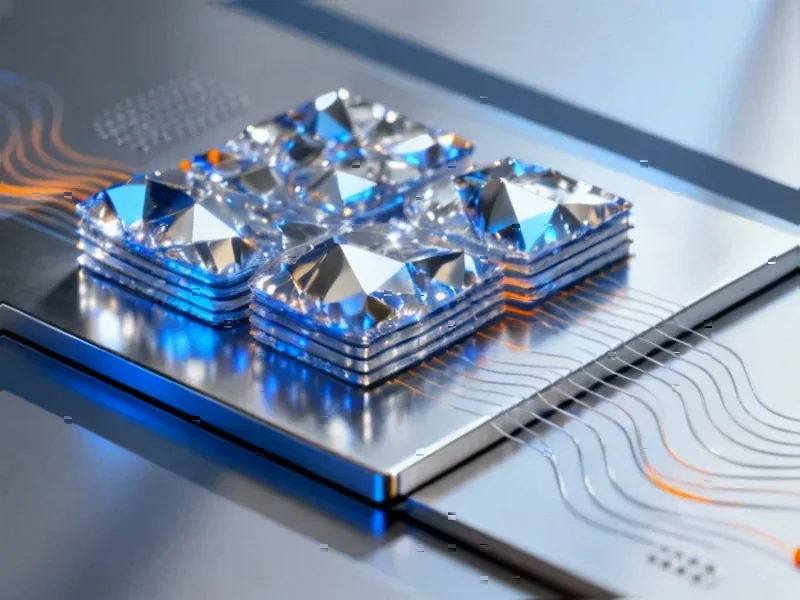According to SciTechDaily, researchers from the USC Viterbi School of Engineering and School of Advanced Computing have developed artificial neurons that physically replicate the electrochemical behavior of real brain cells. The breakthrough, led by Professor Joshua Yang and published in Nature Electronics, uses a “diffusive memristor” device that operates using silver ion movement rather than electron flow. This approach enables each artificial neuron to occupy the space of just one transistor instead of the tens to hundreds required by conventional designs, potentially reducing energy consumption by orders of magnitude. The technology represents a significant step toward artificial general intelligence by more closely mimicking how biological brains process information efficiently.
The Hardware Learning Revolution
What makes this research fundamentally different from previous neuromorphic approaches is its commitment to physical rather than mathematical emulation. Most current AI systems, including those marketed as “neuromorphic,” still rely on software-based learning running on conventional digital hardware. Professor Yang’s insight that “the brain learns by moving ions across membranes” points to a deeper truth about intelligence: learning efficiency may be intrinsically tied to physical implementation. This challenges the entire premise of separating hardware from software in AI development. If successful, this approach could create systems where learning happens directly in the physical substrate, much like biological brains develop neural pathways through physical changes.
The Silver Problem and Manufacturing Challenges
While the research is promising, the choice of silver ions presents significant manufacturing hurdles. As Yang acknowledges, silver isn’t readily compatible with conventional semiconductor processes. The semiconductor industry has spent decades optimizing silicon-based manufacturing, and introducing reactive metals like silver could require entirely new fabrication facilities and processes. Alternative ionic species will need to be identified and tested, potentially delaying commercialization by years. This isn’t just a materials science problem—it’s an economic one. The transition would require massive capital investment at a time when chip manufacturers are already struggling to keep pace with Moore’s Law using established methods.
Energy Efficiency vs. Computational Speed
The trade-off between energy efficiency and computational speed represents another critical challenge. While ions may be more efficient for brain-like computation, electrons remain superior for raw speed. This creates a fundamental tension in system design: do we optimize for learning efficiency or execution speed? Most practical AI applications today require both, and it’s unclear whether diffusive memristors can achieve the clock speeds needed for real-time applications. The human brain’s 20-watt consumption is impressive, but it also operates at dramatically slower “clock speeds” than digital computers. This research might ultimately lead to specialized co-processors for learning tasks rather than complete replacements for conventional computing architectures.
The Scaling Problem
Perhaps the most significant unanswered question is how well these artificial neurons will scale. The research demonstrates capable building blocks, but integrating “large numbers of them” into functional systems presents enormous engineering challenges. Biological brains achieve their efficiency through massively parallel, fault-tolerant architectures that are fundamentally different from the precise, synchronous designs of digital computers. Recreating this at scale requires not just manufacturing breakthroughs but architectural innovations in how these neurons communicate and organize. The history of neuromorphic computing is littered with promising component technologies that failed to deliver when scaled to system-level implementations.
Broader Industry Implications
If these challenges can be overcome, the implications for the AI industry are profound. Current large language models and other AI systems are becoming increasingly unsustainable from an energy perspective. The ability to reduce energy consumption by “orders of magnitude” could make advanced AI accessible to smaller organizations and applications. More importantly, it might enable AI deployment in edge computing scenarios where power constraints currently limit capability. However, this research also suggests that the path to more capable AI might require abandoning some of the architectural assumptions that have driven computing for decades. The transition from electron-based to ion-based computing would represent one of the most fundamental shifts in computing history.
The Road Ahead
While the research is exciting, we should maintain realistic expectations about timelines. Moving from laboratory demonstration to commercial implementation typically takes 5-10 years in semiconductor technology, and this represents a more radical departure than most innovations. The next critical test will be integrating these neurons into functional arrays that can demonstrate meaningful learning tasks. As Yang notes, such systems might also help us “uncover new insights into how the brain itself works,” creating a virtuous cycle between neuroscience and computing. What’s clear is that the era of simply throwing more transistors at AI problems may be ending, and the future might belong to architectures that think more like we do.




